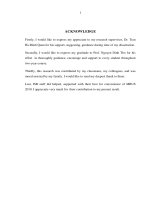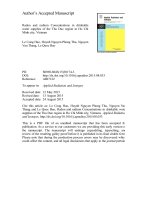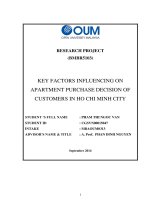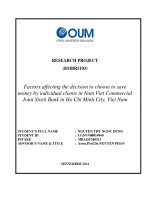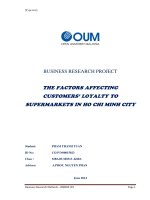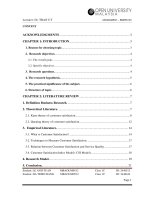The factors affecting on apartment purchase decision on customers in ho chi minh city
Bạn đang xem bản rút gọn của tài liệu. Xem và tải ngay bản đầy đủ của tài liệu tại đây (2.29 MB, 128 trang )
RESEARCH PROJECT
(BMBR5103)
THE FATORS AFFECTING ON
APARTMENT PURCHASE DECISION OF
CUSTOMERS IN HO CHI MINH CITY
STUDENT’S FULL NAME
:
PHAM PHU PHONG
STUDENT ID
:
CGS00018499
INTAKE
:
MBAOUM0914-K15A
ADVISOR’S NAME & TITLE
:
Assoc. Prof. NGUYEN PHAN
December 2015
Page 2
Advisor’s assessment
..........................................................................................................................................
..........................................................................................................................................
..........................................................................................................................................
..........................................................................................................................................
..........................................................................................................................................
..........................................................................................................................................
..........................................................................................................................................
..........................................................................................................................................
..........................................................................................................................................
..........................................................................................................................................
..........................................................................................................................................
..........................................................................................................................................
..........................................................................................................................................
..........................................................................................................................................
..........................................................................................................................................
Advisor’s signature
ACKNOWLEDGEMENTS
I would like to express my most sincere gratitude to Assoc. Prof. Phan Nguyen. I
am deeply indebted for his guidance, patience, valuable comments and suggestions
which greatly helped me in the completion of this dissertation.
I also would like to thank you all my colleagues and friends of HUTECH class for
their valuable contributions to give comments and suggestion to revise the
questionnaire survey.
Warmly thanks to my classmates, friends and all anonymous participants, and
especially my family for their supports and inspiring me to complete the MBA
course.
December 2015
Pham Phu Phong
ABSTRACT
The issue of housing preference has been widely researched in housing literature,
because it provides valuable information for the planning and development of
housing for various residential groups with different needs. In Vietnam, the issue
has not received proper attention from scholars and developers though the local
housing market is going through a phase of rapid development and transformation.
The main purpose of the study is to investigate the effecting of key factors on
housing purchase decision of customers in Ho Chi Minh City with focus on
condominiums in new urban areas, due to strong demand of the residential group
for the specific type of housing.
The thesis employed a stated-preference approach with application of direct
measurement and conjoint analysis methods to answer research question. A total of
400 responses were collected by mean of questionnaires delivered to customers.
The study finds out a strong positive relationship between top two factors, including
“living space”, “distance” and customers’ housing purchase decision. The three
weaker positive relationship factors are “feature”, “finance” and “environment” to
housing decision makers. It is also found that there is no difference in decision
making of customers according to different demographics consisting of gender, age,
marital status, monthly income and education level.
Analysis of the empirical data shows that, households are most concerned about
developers’ commitments and basic quality of the housing units. They appreciate
child-friendly qualities of the living environment, as well as child-friendly facilities
and services, large space, etc. The preferences are then discussed in connection to
current conditions of Ho Chi Minh City urban areas in order to give implications for
urban planning policies and new housing projects.
Key works: housing, purchase factors, Ho Chi Minh City in Vietnam
CONTENTS
ACKNOWLEDGEMENTS
ABSTRACT
LIST OF TABLE
LIST OF FIGURE
LIST OF ABBREVIATIONS
CHAPTER 1. INTRODUCTION .................................................................................. 1
1.1. BACKGROUND .............................................................................................. 1
1.2. RESEARCH OBJECTIVES ............................................................................. 2
1.3. RESEARCH QUESTIONS .............................................................................. 2
1.4. OBJECT OF STUDY ....................................................................................... 3
1.5. SCOPE OF STUDY ......................................................................................... 3
1.6. METHODOLOGY ........................................................................................... 4
CHAPTER 2. LITERATURE REVIEW ....................................................................... 5
2.1. INTRODUCTION.............................................................................................. 5
2.2. APARTMENT MARKET IN VIETNAM OVERVIEW ................................... 5
2.3. FORECASTS APARTMENTS MARKET IN 2015 - 2016 ............................. 10
2.4. BEHAVIOUR IN PURCHASE DECISION OF CUSTOMER ....................... 12
2.5. THE FACTORS IMPACT ON PURCHASE DECISION APARTMENT OF
CUSTOMER ............................................................................................................ 16
CHAPTER 3: RESEARCH METHODOLOGY ......................................................... 20
3.1. RESEARCH DESIGN ...................................................................................... 20
3.2. SAMPLE SIZE.................................................................................................. 21
3.3. RESEARCH PROCESS.................................................................................... 22
3.4. RESEARCH MODEL ....................................................................................... 25
3.5. MEASUREMENT SCALE ............................................................................... 27
3.5.1. Measurement scale factors affecting apartment buying decision .................. 27
3.6. MAIN SURVEY ............................................................................................... 30
3.7. DATA ANALYSIS METHOD ......................................................................... 31
3.7.1. Reliability measure......................................................................................... 31
3.7.2. Validity measure by EFA (Exploratory Factor Analysis) .......................... 31
3.7.3. Multiple regression analysis ....................................................................... 32
CHAPTER 4: DATA ANALYSIS AND RESULTS .................................................. 34
4.1. STATISTICAL SAMPLES .............................................................................. 34
4.2. ASSESSMENT MEASUREMENT SCALE .................................................... 37
4.3. MULTIPLE REGRESSION ANALYSIS ........................................................ 47
4.4. HYPOTHESIS TESTING BY MULTIPLE REGRESSION ........................... 51
CHAPTER 5: CONCLUSIONS AND IMPLICATIONS ........................................... 57
5.1. RESEARCH OVERVIEW................................................................................ 57
5.2. RESEARCH FINDINGS .................................................................................. 58
5.3. MANAGERIAL IMPLICATION ..................................................................... 59
REFERENCES ............................................................................................................. 61
APPENDIX .................................................................................................................. 66
LIST OF TABLE
Table 3.5: Main factors affecting customer’ housing decision
Table 4.1: Characteristics of respondents
Table 4.2: Cronbach’s Alpha test results
Table 4.3: Total testing results scales
Table 4.4: EFA results
Table 4.5: EFA results analysis Factor of scale purchase Decision
Table 4.6: EFA results analysis Factor adjusted
Table 4.7: Correlation among variables
Table 4.8: Indicators for assessment the relevance of model (Model Summary)
Table 4.9: Regression Model
Table 4.10: Coefficient Regression Results
Table 4.11: Hypotheses results
LIST OF FIGURE
Figure 2.2: Condominium market in HCMC Q3-2015
Figure 2.4.3: General model of consumer behavior
Figure 2.4.4: Model of consumer behavior (Kotler, 1999)
Figure 3.1: Research design
Figure 3.3: Research process
Figure 3.4: Research model
Figure 4.1: Adjust the research model
Figure 4.4: Official research model
LIST OF ABBREVIATIONS
ANOVA
Analysis Of Variance
CFA
Confirmatory Factor Analysis
EFA
Exploratory Factor Analysis
SPSS
Statistical Package for Social Scientists
EFA
Exploratory Factor Analysis
GSO
Vietnam Government Statistics Office
HCMC
Ho Chi Minh City
Mil.
Million
MLR
Multiple Linear Regression
CHAPTER 1. INTRODUCTION
1.1.
BACKGROUND
The property market in Vietnam is showing signs of getting warmer and industry
insiders do not think there will be another real estate bubble as there was seven
years ago. The latest housing bubble occurred in Vietnam in the 2007-2008 period,
when investors rushed to the realty sector after the stock market went into a crisis.
The bubble then quickly burst, leaving the market frozen with a huge number of
unsold land plots, houses, and apartments (Young news, 2015). Thanks to strong
economic growth, and a growing middle class, after almost five years of a housing
slump but most important is the new Housing Law and the Law on Real Estate
Business. These came into effect in July 2015, and allow foreigners and overseas
Vietnamese to legally own, sell and transfer real properties (Global property guide,
2015).
As many as 5,150 apartments were put on sale in the first quarter of this year, three
times the figure last year, according to a survey by realty consultant CBRE (CBRE
Releases Q3/2015 Quarterly Report Highlights for Ho Chi Minh City Market).
The number of new apartments in the first quarter rose 40 percent year on year,
which consultancy Savills said is the strongest growth since February 2011.
Most apartment purchasers in Ho Chi Minh City in the year to date have been real
homebuyers, who buy to live there, rather than speculators and secondary investors
who purchase to resell, according to industry insiders.
Real estate trading floors in the city are receiving more customers than this time last
year, and more purchase contracts have also been closed.
According to the report of “Vietnam Housing Sector Forecast to 2015” indicates the
housing requirement is rising with trend of nuclear families has created immense
demand expected to grow around 6% during 2012-2015.
1
The condominiums in new urban areas are preferred by many young people because
the types of condominiums offer various advantages over traditional housing types
such as: lower price, good infrastructure with various facilities and services which
are suitable for the needs. The demand of young people for condominiums has been
increasing massively in recent few years.
One of the most significant economic decisions of everybody is buying a house
oneself. The need of dwelling is practical and more increasingly when the
population is growing and choosing big cities for permanent residency.
However, according to the Deputy Minister of Construction Nguyen Tran Nam
(2015), he emphasized that “people’s housing demand is very large and solvency is
high, but the real estate market lacked of information”.
This thesis focuses on factors which influence on people's purchase decision toward
apartments/condominiums in Ho Chi Minh City.
1.2.
RESEARCH OBJECTIVES
To determine factors affecting on apartment purchase decision of customers in Ho
Chi Minh city.
The thesis aims to understand buying behavior of people in HCM City by studying
their decision making process and type of buying behavior.
Research results, the proposed use research results to promote customer orientation
purchasing decision apartments in the current market.
1.3.
RESEARCH QUESTIONS
Consequently, in the term of real estate purchase decision of customers, the research
questions of the thesis are raised as two following questions
2
Based on this situation, I would like to point out some problems to correspond to
questions stated as follow:
-
What are main factors influencing on apartment purchase decision of
customers in HCMC?
-
How is impact of these factors on apartment purchase decision of customers
evaluated in HCM context?
Understanding relationship between main factors affecting customer house purchase
decision is an important role for both real estate developers and enterprises to
satisfy customers’ demand and to have available strategies in the real estate field.
1.4.
OBJECT OF STUDY
The factors affecting on apartment purchase decision of customers in Ho Chi Minh
city.
The objects survey are customers intend to purchase or have purchased senior
apartments or medium in Ho Chi Minh city.
1.5.
SCOPE OF STUDY
The study scope should be surveyed in apartment segment at HCM City where is
considered a typical representative is given its population profile, excellent
demographic statistical data in general The research only focuses on key factors
which influence to demand of residential apartment.
Target respondents for this thesis should be people who are living and working in
HCMC.
3
1.6.
METHODOLOGY
The real estate is a broad topic requires further deeply research with consuming
significant time and efforts. This thesis is relatively provided merely firsthand
information to assess real demand and determinants impact on residential apartment
buying decision.
Research methodology is an important part of the whole process of research to
determine how the research should be undertaken.
In order to achieve the objective, both primary data and secondary data are collected
to use in the thesis:
The primary data is gained by distributing questionnaire on residential apartment
purchasing decision to study key factors influence on. The questionnaire consists of
3 parts: socio-demographic; apartment preference pattern; apartment purchasing
intention; factors influence on buying decision.
The secondary data is collected from a wide variety of reliable sources including
academic books, articles, newspapers, magazines, journals, publications, reports of
real estate companies, official websites. Data related to apartment market in HCM
City, definition and theory of apartment preference pattern; apartment purchasing
intention; decision making process and previous finding will be utilized in the
thesis.
By analyzing results of the primary data and compiling the secondary data
The research method refers to techniques and procedures
The research methodology refers to research designs and data collection via
questionnaires.
The inductive approach should be applied for this research to draw results from data
collected and analysis and empirical observation.
4
CHAPTER 2. LITERATURE REVIEW
2.1. INTRODUCTION
This chapter presents overview of previous literatures relating to apartment
purchase decision making of customers. Also, a conceptual framework is built up
and relative hypotheses of research are raised.
A variety of studies focuses on housing characteristics such as cost, size and
location. Others give attention to demographic characteristics such as age, sex and
income as determinants of preference. Some investigate housing preference in the
connection with family life cycle and residential mobility.
2.2. APARTMENT MARKET IN VIETNAM OVERVIEW
According to David R. Henderson, the concise of encyclopedia of economic (David,
2002), the law of demand is built almost the whole edifice of economics. The law of
demand states that when the price of a good rises, the amount demanded falls, and
when the price falls, the amount demanded rises. However, the real estate industry
does not always apply this law conclusively. The effective housing demand is the
amount of housing for which the population is willing and able to pay. The effective
housing demand for private housing is volatile and has been affected in the past by
the market supply and market allocation mechanism. There are many factors impact
on demand and decision of buyer of apartments such as: price, financing supports,
household income, features of apartment, legal framework, developer, contractor,
management etc.
Potential buyers have been divided into two subgroups: residents who buy and sell
houses for personal use, and speculators and property developers who make money
by selling and buying property (Roehner, 1999).
5
Residents’ choice to migrate from one city to another depends on the employment,
income and political and social environments. (Dieleman et al., 2000) demonstrated
that, population growth and employment growth seem to create differences in the
rate of turnover and the differences in price levers. Many researchers claim that
income is an important determinant of housing demand.
The population density in HCMC could be considered highest with the average
density in the central at 27,000 persons per km2 when comparing with density cities
in the world, namely Singapore and Hong Kong where high-rise apartment
buildings are ubiquitous. The density in Hong Kong Island stands at 16,000 persons
per km2 (2008) (Census & Hong Kong., 2009), and the density in Singapore is 7100
persons per km2 (2010) (Department of Statistics, 2010) (Jieming Zhu, 2011).
Another factor influences on demand of buying apartment is financing support from
bank and government. Credit constraints in the form of down payment requirements
significantly affect housing consumption for many buyers. Bank loans are usually
required by most households to finance their purchases. The credit or financial
market typically cannot lend on the basis of the borrower’s expected future income
prospects. Therefore, current income and current financial assets then become
important indicators of a borrower’s means of repaying a loan. The availability of
housing loans and government subsidies will influence consumers’ choice of
whether or not to buy a home (Omar and Ruddock, 2002). The demand for housing
also depends on the mortgage rates and the general level of consumer confidence
(Tutoru, 2003).
The study of RNCOS (Business Consultancy Services) on Vietnam Housing Sector
Forecast to 2015, one of issues relating to housing demand of Vietnamese is
affordability. The report studies the affordability scenario of Vietnam and found
that house price to household income ratio is much higher than the neighboring
regions, creating vast gap between house price and affordability.
6
Young people live in big cities such as Ha Noi, Da Nang, and HCMC have great
demand of housing based on various experiences of life milestones (adulthood,
education and graduation stages, job seeking, and occupation path, leaving parental
home, job opportunities, marriage and children). These various experiences
somehow influence on demands of housing types, attributes and services associated
into.
But the price of residential condominium in HCMC is still quite high and people
tends to purchase apartments depends on the level of disposable income (Bible &
Hsieh, 2001; Brandy & Parsons, 2002). High level of disposable income will
increase the ability of spending and especially in purchase of housing is a major
goal of most people.
Firstly, price is one of important determinants of a household choice and buying
decision. However, unlike other consumption goods, the housing market is unique
because it manifests the characteristics of durability, heterogeneity, and spatial
fixity. Thus, to model this differentiation effectively, the second approach of the
hedonic price model has been introduced. The hedonic price model posits that
goods are typically sold as a package of inherent attributes (Rosen, 1974).
Therefore, the price of one house relative to another will differ with the additional
unit of the different attributes inherent in one house relative to another house. The
relative price of a house is then the summation of all its marginal or implicit prices
estimated through the regression analysis. The market price of a housing unit’s
bundle of inherent attributes, such as: location, structure and neighborhood or
environment attributes (Freeman, 1979).
The house price determination is associated with macro (market-related factors) and
micro (house-specific factors). How do the researchers link these factors to the
price? The first step to this is to establish theoretical background for the pricing
theory. Thus, the review begins with identifying price determinants. The review will
then followed by discussion on the utilization of statistical tool as one of the
7
approaches available to segregate the contribution of each variable hence enabling
the quantification of perceived contribution in the overall price.
In this thesis, the micro factors (house-specific factors should be focused replace for
macro factors (such as: interest rates, inflation rates, taxes are critical explanations
for setting price from developers). The micro factors could be derived from buyers
of apartments in evaluating factors such as: structural (physical characteristic),
location and life environment attributes (contain of neighborhood) impact on buying
decision process.
During last economic recession years, there was a phenomenon of bubble real estate
industry where the price of apartment segment had pushed up very high and caused
customers who have real need could be unaffordable to buy. This had been
occurring problem of affordability and inequality (Yip, 2008) and major real estate
developers, private and public alike to focus on squeezing into higher end market
and this had made low income workers out of reach for new flats.
The city government increasingly seeks solutions to support middle income and low
income group could be affordable to buy apartment (SGGP News, 2013).
According to HCMC Real Estate Association said many capable Vietnamese
businesses have channeled their capital into the luxury housing sector to satisfy
demand of high income groups, while affordable housing apartments for lowincome people has fallen short. The unbalanced supply of accommodation has now
left a large unsold inventory.
The HCMC real estate market remains positively stable in this quarter and the
upward trend of FDI and M&A is expected to continue for the foreseeable future
(CBRE Releases Q3/2015 Quarterly Report Highlights for Ho Chi Minh City
Market).
In Q3 2015, positive market momentum continued, boosting new launch activities
and sales performance. A total of 10,114 new units were launched from 26 projects,
triple the number seen in Q3 2014. Ms. Dung Duong, Director of CBRE Vietnam’s
8
Research and Consulting, shared that by location, new supply from the South
(encompassing districts 4, 7, 8, and Nha Be Commune) accounted for 36% of the
total new launched stock, while the recent hot spot in the East (districts 2, 9, Binh
Thanh and Thu Duc) accounted for a more modest 29% this quarter. Ms. Dung
further highlighted, “It is interesting to once again see Southern properties taking
the lead compared to the East, particularly following the recent news that HCMC
plans to develop its first special economic zone (SEZ) in the East of HCMC
encompassing districts 7, Nha Be, part of Binh Chanh and Can Gio with a focus on
marine economy. Vingroup has also announced to partner up with Saigon Port to
develop a 32 hectare prime site at the removed Khanh Hoi Port in District 4 in the
East zone. The market is believed to witness more competition between these two
hot zones in the coming time, especially in the context that now Thu Thiem New
Urban Area in the East has been started its development with the first condominium
blocks called Sarimi being launched in Q3 2015.” The review quarter also
witnessed a repackaging of some long-delayed projects where new developers have
taken over and revitalised developments by providing more finance or redesigning
unit layout, size and mix. These projects include City Gate Towers (District 8), Linh
Tay Tower (Thu Duc District), and C.T. Plaza Nguyen Hong (Go Vap District)
Figure 2.2.
Three months after new regulations came into effect some initial interest from
foreign buyers has been recorded. Mr. Marc Townsend, Managing Director of
CBRE Vietnam, commented, “There has not been a notable increase in sales to
foreigners to date as many potential buyers are awaiting more guidance and
progress in implementation. Being an agent initiatively targeting at this group of
buyers, we have observed that professionalism, language proficiency and ease of
credit card payment are some of the key issues once foreign buyers are involved.”
9
Figure 2.2: Condominium market in HCMC Q3-2015
2.3. FORECASTS APARTMENTS MARKET IN 2015 - 2016
According to Savills research (Briefing apartment sector, 2015), from Q4/2015 to
2017, approximately 57,500 new units from 92 existing and future projects are
expected to enter the market. Approximately 33% of the total future supply is
expected to be completed in 2015 and 2016.
VNREA forecast in 2016, the real estate market continues to grow thanks to
favorable macroeconomic factors, the lure of mergers and M & A in the field is
capable of exploding in the period 2016 to 2017 by the Vietnam visit Family deeper
on the path of regional integration and globalization.
Specifically, Vietnam is a country that will benefit most, thanks to flexible
conditions than the Member States Economic Partnership Agreement Trans-Pacific
(TPP) other. Therefore, in the next 4-5 years, a number of economic sectors in
Vietnam will benefit and strong growth, including real estate.
10
At the same time, the ASEAN Economic Community (AEC) will be formally
established in late 2015, the real estate market in Southeast Asia will become the
focus in the sights of international investors.
With policies on housing and real estate business has been enforced, that Vietnam
has VNREA well prepared to catch the wave of international investment.
Based on the business performance of realty firms this year, experts believed that
Vietnam real estate market will become better in 2016.
Thanks to increasing demand and new regulations of the 2014 Housing Law and the
2014 Law on Real Estate Business, leading experts said the market would be more
buoyed next year.
A recent report of Hung Thinh Real Estate Exchange JSC (Hung Thinh Land)
revealed that the firm has sold around 4,500 apartments since the beginning of
2015, nearly reaching the sales target of 5,000 units for the whole year.
Nguyen Nam Hien - General Director of Hung Thinh Land said the firm has more
customers who have searched for medium-end apartments with good prices. For
2016, Hung Thinh Land plans to expand operation, with the aim of distributing
more products developed by its parent company Hung Thinh Corp.
Besides, Dat Xanh Group plans to launch 4,000-6,000 apartments onto the market
per year, apart from villas and urban land lots by 2020.
This year, many major Ho Chi Minh City-based real estate trading floors expect to
sell 1,000 - 3,000 apartments and land lots. These ambitious targets would be
maintained for 2016.
Chairman of the Ho Chi Minh Real Estate Association (HoREA) Le Hoang Chau
forecasted that property market recovery would continue in 2016.
Prices at various housing projects in HCMC have been 5-15% higher this year,
Chau added. However, he also stressed that there is no sign of a real estate bubble in
the coming time.
11
At a recent conference on the 2016 real estate market trends, Prof. Dang Hung Vo former Deputy Minister of Natural Resources and Environment said there have been
more positive signs for the domestic market, such as increased disbursements of
loans for housing projects, more successful transactions and falling inventories.
According Prof. Dang Hung Vo, analyzed that when a real estate bubble occurred in
previous years, property prices skyrocketed at least 1% per day. For the next years,
however, thanks to the new legal documents and higher market transparency, the
domestic market will not experience such price rallies.
2.4. BEHAVIOUR IN PURCHASE DECISION OF CUSTOMER
Study of consumer behavior is very important because intentionally or
unintentionally we are consumer. With the philosophy of marketing production
trend to marketing trend of consumer behavior has been important. In marketing
some question create that as a marketer we should pay attention to them and provide
a reasonable answer for them. One of the following questions is: What is the
purpose of consumer behavior? Considering that a marketer seeking to identify the
needs and demands of our customers and do the appropriate action to meet those
needs and desires, should understand Consumer behavior as well. In this study, the
researcher wants to explain his view according to previous studies briefly in
consumer behavior.
2.4.1 Definition of Consumer Behavior
Consumer behavior in marketing is a new issue. So that the first books published
does not reach before 1968 in this field. Most universities do not make any effort
before 1970, but it has grown significantly in recent years, So that a special team of
investigators was formed in 1970 about consumer behavior and in 1990 the group
12
had 1500 members from 30 countries
Definition: Consumer behavior include mental activity, emotional and physical that
people use during selection, purchase, use and dispose of products and services that
satisfy their needs and desires (Kotler, 1999)
2.4.2. Key concepts of consumer behavior
1) Consumer behavior is motivational: The main question that arises in this context
is that "why consumer behaviors occur?”. Answer to this question is included in the
definition of consumer behavior. Consumer behavior is to meet the needs and
demands of him. Behavior is a tool to achieve objectives and target consumer
derives from his needs and desires (Wilke, 2000).
2) Consumer behavior include many activities: All consumers have differences in
terms of thoughts, feelings, and decisions and etc. With each other, marketers must
pay attention to the activities of consumers, some consumers activities are: See this
advertisement, purchase decision, the decision about how to pay (cash, credit) and
etc.
3) Consumer behavior is a process: Consumer behavior, including the selection,
purchase and consumption of goods and services that include elimination of three
steps before buying activities, purchasing activities, activities after purchase
(Rostami, 2001).
4) Consumer behavior at different times has different complexity: Buy different
product by different people has different implications. Buy some goods, involves all
three process step of the consumer Behavior, while buying some goods (goods that
are consumed regularly) is very simple and does not require multiple steps.
Customers try to make buying process simple through trusting others, loyalty to the
brand and .etc.
5) Consumer behavior includes different roles: Consumers in different time can play
13
each of the three roles affective, buyers and consumer. When we buy something for
our self we can play that 3 role (Golchinfar, 2006). Sometime by using others
opinion buy something for some one that in this case we can play an individual role.
6) Consumer behavior is influenced by external factors: Consumer behavior is
influenced by many external factors such as culture, subculture, social classes .etc.
These effects can be short, medium or long term.
7) Consumer behavior is different in different people: Because people have different
desires and needs, so their behavior is different And the difference consumer
behavior make predict consumer behavior more difficult, to resolve this problem
can categories the market (Abbasi & Torkamani, 2010).
2.4.3. Consumer buying decision process
Consumers can purchase different products And this difference because that
different buying decisions buying process consists of several steps in Figure 1
(taken from the site abercrombie.com) presented. Consumers to purchase some
goods don’t need to pass during all stages of the buying decision. However, some
purchases are so important that the consumer is forced to do all these steps carefully
and meticulously (Gilani Nia, 2010). These steps include:
1) Identify the problem: The first stage of the decision-making process is that
people can feel the difference between current and desired situation, so trying to
resolve these differences.
2) Data collection: For solving this problem collect information. This information
can be internal (experiences) and external (family, exhibits, etc.)
3) Assessment Options: After gathering information, the consumer is ready to make
a decision. At this point, he should be able to evaluate different options and choose
products that meet the demands of him.
4) Purchase: This stage is the stage that all marketing activities are the result.
14
Consumer at this stage, according to the information already obtained, Select a
product that feels satisfy his need and buys it.
5) After purchase behavior: Consumer compare purchased products with ideas,
products, competitors, perceptions and expectations of the product and two
satisfaction and dissatisfaction, which may appear different reasons.
Figure 2.4.3: General model of consumer behavior
In the past, sellers, due to lack of competition and lower a variety of products
directly sell the product. But today, by increasing companies, increasing
competition and increasing revenues from other people, other sellers will not be
15
able to communicate directly with sellers. Marketers and sellers are forced to study
consumer behavior research. Now the question comes, who the buyers? When do
they Purchase? And etc. But the important question is how consumers respond to
marketing stimuli? The company is rated from consumer responses to be aware
marketing stimuli, so companies in relationship between marketing stimuli and
consumer response, have been done many studies. Starting point for this research is
shown in Figure 2. As the figure shows, the marketing stimuli associated with other
stimulants into the black box of the consumer and this will cause a reaction in the
black box. Now, marketers want to know what is going on in the black box. Black
Box itself is composed of two parts. First part personal characteristics of buyer on
how to understand and respond to stimuli affect and the second part is the buyer's
decision-making process that effects on his behavior.
Figure 2.4.4: Model of consumer behavior (Kotler, 1999)
2.5. THE FACTORS IMPACT ON PURCHASE DECISION APARTMENT
OF CUSTOMER
Haurin (2002) demonstrated that, owning one house will be improve the family
environment, including the child's life, improves cognition and reduces behavioral
16
